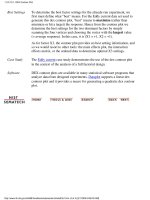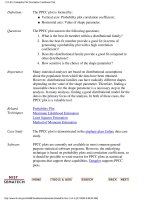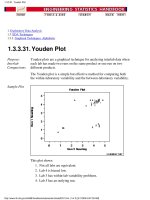Engineering Statistics Handbook Episode 1 Part 7 pptx
Bạn đang xem bản rút gọn của tài liệu. Xem và tải ngay bản đầy đủ của tài liệu tại đây (79.21 KB, 17 trang )
Definition:
Group
Slopes
Versus
Group ID
Linear slope plots are formed by:
Vertical axis: Group slopes from linear fits
●
Horizontal axis: Group identifier●
A reference line is plotted at the slope from a linear fit using all the
data.
Questions The linear slope plot can be used to answer the following questions.
Do you get the same slope across groups for linear fits?1.
If the slopes differ, is there a discernible pattern in the slopes?2.
Importance:
Checking
Group
Homogeneity
For grouped data, it may be important to know whether the different
groups are homogeneous (i.e., similar) or heterogeneous (i.e., different).
Linear slope plots help answer this question in the context of linear
fitting.
Related
Techniques
Linear Intercept Plot
Linear Correlation Plot
Linear Residual Standard Deviation Plot
Linear Fitting
Case Study
The linear slope plot is demonstrated in the Alaska pipeline data case
study.
Software Most general purpose statistical software programs do not support a
linear slope plot. However, if the statistical program can generate linear
fits over a group, it should be feasible to write a macro to generate this
plot. Dataplot supports a linear slope plot.
1.3.3.18. Linear Slope Plot
(2 of 2) [5/1/2006 9:56:48 AM]
1. Exploratory Data Analysis
1.3. EDA Techniques
1.3.3. Graphical Techniques: Alphabetic
1.3.3.19.Linear Residual Standard
Deviation Plot
Purpose:
Detect
Changes in
Linear
Residual
Standard
Deviation
Between
Groups
Linear residual standard deviation (RESSD) plots are used to
graphically assess whether or not linear fits are consistent across
groups. That is, if your data have groups, you may want to know if a
single fit can be used across all the groups or whether separate fits are
required for each group.
The residual standard deviation is a goodness-of-fit measure. That is,
the smaller the residual standard deviation, the closer is the fit to the
data.
Linear RESSD plots are typically used in conjunction with linear
intercept and linear slope plots. The linear intercept and slope plots
convey whether or not the fits are consistent across groups while the
linear RESSD plot conveys whether the adequacy of the fit is consistent
across groups.
In some cases you might not have groups. Instead, you have different
data sets and you want to know if the same fit can be adequately applied
to each of the data sets. In this case, simply think of each distinct data
set as a group and apply the linear RESSD plot as for groups.
1.3.3.19. Linear Residual Standard Deviation Plot
(1 of 3) [5/1/2006 9:56:48 AM]
Sample Plot
This linear RESSD plot shows that the residual standard deviations
from a linear fit are about 0.0025 for all the groups.
Definition:
Group
Residual
Standard
Deviation
Versus
Group ID
Linear RESSD plots are formed by:
Vertical axis: Group residual standard deviations from linear fits
●
Horizontal axis: Group identifier●
A reference line is plotted at the residual standard deviation from a
linear fit using all the data. This reference line will typically be much
greater than any of the individual residual standard deviations.
Questions The linear RESSD plot can be used to answer the following questions.
Is the residual standard deviation from a linear fit constant across
groups?
1.
If the residual standard deviations vary, is there a discernible
pattern across the groups?
2.
Importance:
Checking
Group
Homogeneity
For grouped data, it may be important to know whether the different
groups are homogeneous (i.e., similar) or heterogeneous (i.e., different).
Linear RESSD plots help answer this question in the context of linear
fitting.
1.3.3.19. Linear Residual Standard Deviation Plot
(2 of 3) [5/1/2006 9:56:48 AM]
Related
Techniques
Linear Intercept Plot
Linear Slope Plot
Linear Correlation Plot
Linear Fitting
Case Study The linear residual standard deviation plot is demonstrated in the
Alaska pipeline data case study.
Software Most general purpose statistical software programs do not support a
linear residual standard deviation plot. However, if the statistical
program can generate linear fits over a group, it should be feasible to
write a macro to generate this plot. Dataplot supports a linear residual
standard deviation plot.
1.3.3.19. Linear Residual Standard Deviation Plot
(3 of 3) [5/1/2006 9:56:48 AM]
Sample Plot
This sample mean plot shows a shift of location after the 6th month.
Definition:
Group
Means
Versus
Group ID
Mean plots are formed by:
Vertical axis: Group mean
●
Horizontal axis: Group identifier●
A reference line is plotted at the overall mean.
Questions The mean plot can be used to answer the following questions.
Are there any shifts in location?1.
What is the magnitude of the shifts in location?2.
Is there a distinct pattern in the shifts in location?3.
Importance:
Checking
Assumptions
A common assumption in 1-factor analyses is that of constant location.
That is, the location is the same for different levels of the factor
variable. The mean plot provides a graphical check for that assumption.
A common assumption for univariate data is that the location is
constant. By grouping the data into equal intervals, the mean plot can
provide a graphical test of this assumption.
Related
Techniques
Standard Deviation Plot
Dex Mean Plot
Box Plot
1.3.3.20. Mean Plot
(2 of 3) [5/1/2006 9:56:48 AM]
Software Most general purpose statistical software programs do not support a
mean plot. However, if the statistical program can generate the mean
over a group, it should be feasible to write a macro to generate this plot.
Dataplot supports a mean plot.
1.3.3.20. Mean Plot
(3 of 3) [5/1/2006 9:56:48 AM]
Definition:
Ordered
Response
Values Versus
Normal Order
Statistic
Medians
The normal probability plot is formed by:
Vertical axis: Ordered response values
●
Horizontal axis: Normal order statistic medians●
The observations are plotted as a function of the corresponding normal
order statistic medians which are defined as:
N(i) = G(U(i))
where U(i) are the uniform order statistic medians (defined below) and
G is the percent point function of the normal distribution. The percent
point function is the inverse of the cumulative distribution function
(probability that x is less than or equal to some value). That is, given a
probability, we want the corresponding x of the cumulative
distribution function.
The uniform order statistic medians are defined as:
m(i) = 1 - m(n) for i = 1
m(i) = (i - 0.3175)/(n + 0.365) for i = 2, 3, , n-1
m(i) = 0.5
(1/n)
for i = n
In addition, a straight line can be fit to the points and added as a
reference line. The further the points vary from this line, the greater
the indication of departures from normality.
Probability plots for distributions other than the normal are computed
in exactly the same way. The normal percent point function (the G) is
simply replaced by the percent point function of the desired
distribution. That is, a probability plot can easily be generated for any
distribution for which you have the percent point function.
One advantage of this method of computing probability plots is that
the intercept and slope estimates of the fitted line are in fact estimates
for the location and scale parameters of the distribution. Although this
is not too important for the normal distribution since the location and
scale are estimated by the mean and standard deviation, respectively, it
can be useful for many other distributions.
The correlation coefficient of the points on the normal probability plot
can be compared to a table of critical values to provide a formal test of
the hypothesis that the data come from a normal distribution.
Questions The normal probability plot is used to answer the following questions.
Are the data normally distributed?1.
What is the nature of the departure from normality (data
skewed, shorter than expected tails, longer than expected tails)?
2.
1.3.3.21. Normal Probability Plot
(2 of 3) [5/1/2006 9:56:49 AM]
Importance:
Check
Normality
Assumption
The underlying assumptions for a measurement process are that the
data should behave like:
random drawings;1.
from a fixed distribution;2.
with fixed location;3.
with fixed scale.4.
Probability plots are used to assess the assumption of a fixed
distribution. In particular, most statistical models are of the form:
response = deterministic + random
where the deterministic part is the fit and the random part is error. This
error component in most common statistical models is specifically
assumed to be normally distributed with fixed location and scale. This
is the most frequent application of normal probability plots. That is, a
model is fit and a normal probability plot is generated for the residuals
from the fitted model. If the residuals from the fitted model are not
normally distributed, then one of the major assumptions of the model
has been violated.
Examples
Data are normally distributed1.
Data have fat tails2.
Data have short tails3.
Data are skewed right4.
Related
Techniques
Histogram
Probability plots for other distributions (e.g., Weibull)
Probability plot correlation coefficient plot (PPCC plot)
Anderson-Darling Goodness-of-Fit Test
Chi-Square Goodness-of-Fit Test
Kolmogorov-Smirnov Goodness-of-Fit Test
Case Study
The normal probability plot is demonstrated in the heat flow meter
data case study.
Software Most general purpose statistical software programs can generate a
normal probability plot. Dataplot supports a normal probability plot.
1.3.3.21. Normal Probability Plot
(3 of 3) [5/1/2006 9:56:49 AM]
Discussion Visually, the probability plot shows a strongly linear pattern. This is
verified by the correlation coefficient of 0.9989 of the line fit to the
probability plot. The fact that the points in the lower and upper extremes
of the plot do not deviate significantly from the straight-line pattern
indicates that there are not any significant outliers (relative to a normal
distribution).
In this case, we can quite reasonably conclude that the normal
distribution provides an excellent model for the data. The intercept and
slope of the fitted line give estimates of 9.26 and 0.023 for the location
and scale parameters of the fitted normal distribution.
1.3.3.21.1. Normal Probability Plot: Normally Distributed Data
(2 of 2) [5/1/2006 9:56:50 AM]
Discussion For data with short tails relative to the normal distribution, the
non-linearity of the normal probability plot shows up in two ways. First,
the middle of the data shows an S-like pattern. This is common for both
short and long tails. Second, the first few and the last few points show a
marked departure from the reference fitted line. In comparing this plot
to the long tail example in the next section, the important difference is
the direction of the departure from the fitted line for the first few and
last few points. For short tails, the first few points show increasing
departure from the fitted line above the line and last few points show
increasing departure from the fitted line below the line. For long tails,
this pattern is reversed.
In this case, we can reasonably conclude that the normal distribution
does not provide an adequate fit for this data set. For probability plots
that indicate short-tailed distributions, the next step might be to generate
a Tukey Lambda PPCC plot. The Tukey Lambda PPCC plot can often
be helpful in identifying an appropriate distributional family.
1.3.3.21.2. Normal Probability Plot: Data Have Short Tails
(2 of 2) [5/1/2006 9:56:50 AM]
Discussion For data with long tails relative to the normal distribution, the
non-linearity of the normal probability plot can show up in two ways.
First, the middle of the data may show an S-like pattern. This is
common for both short and long tails. In this particular case, the S
pattern in the middle is fairly mild. Second, the first few and the last few
points show marked departure from the reference fitted line. In the plot
above, this is most noticeable for the first few data points. In comparing
this plot to the short-tail example in the previous section, the important
difference is the direction of the departure from the fitted line for the
first few and the last few points. For long tails, the first few points show
increasing departure from the fitted line below the line and last few
points show increasing departure from the fitted line above the line. For
short tails, this pattern is reversed.
In this case we can reasonably conclude that the normal distribution can
be improved upon as a model for these data. For probability plots that
indicate long-tailed distributions, the next step might be to generate a
Tukey Lambda PPCC plot. The Tukey Lambda PPCC plot can often be
helpful in identifying an appropriate distributional family.
1.3.3.21.3. Normal Probability Plot: Data Have Long Tails
(2 of 2) [5/1/2006 9:56:51 AM]
Discussion This quadratic pattern in the normal probability plot is the signature of a
significantly right-skewed data set. Similarly, if all the points on the
normal probability plot fell above the reference line connecting the first
and last points, that would be the signature pattern for a significantly
left-skewed data set.
In this case we can quite reasonably conclude that we need to model
these data with a right skewed distribution such as the Weibull or
lognormal.
1.3.3.21.4. Normal Probability Plot: Data are Skewed Right
(2 of 2) [5/1/2006 9:56:51 AM]
Sample Plot
This data is a set of 500 Weibull random numbers with a shape
parameter = 2, location parameter = 0, and scale parameter = 1. The
Weibull probability plot indicates that the Weibull distribution does in
fact fit these data well.
Definition:
Ordered
Response
Values
Versus Order
Statistic
Medians for
the Given
Distribution
The probability plot is formed by:
Vertical axis: Ordered response values
●
Horizontal axis: Order statistic medians for the given distribution●
The order statistic medians are defined as:
N(i) = G(U(i))
where the U(i) are the uniform order statistic medians (defined below)
and G is the percent point function for the desired distribution. The
percent point function is the inverse of the cumulative distribution
function (probability that x is less than or equal to some value). That is,
given a probability, we want the corresponding x of the cumulative
distribution function.
The uniform order statistic medians are defined as:
m(i) = 1 - m(n) for i = 1
m(i) = (i - 0.3175)/(n + 0.365) for i = 2, 3, , n-1
m(i) = 0.5**(1/n) for i = n
In addition, a straight line can be fit to the points and added as a
reference line. The further the points vary from this line, the greater the
1.3.3.22. Probability Plot
(2 of 4) [5/1/2006 9:56:52 AM]
indication of a departure from the specified distribution.
This definition implies that a probability plot can be easily generated
for any distribution for which the percent point function can be
computed.
One advantage of this method of computing proability plots is that the
intercept and slope estimates of the fitted line are in fact estimates for
the location and scale parameters of the distribution. Although this is
not too important for the normal distribution (the location and scale are
estimated by the mean and standard deviation, respectively), it can be
useful for many other distributions.
Questions The probability plot is used to answer the following questions:
Does a given distribution, such as the Weibull, provide a good fit
to my data?
●
What distribution best fits my data?●
What are good estimates for the location and scale parameters of
the chosen distribution?
●
Importance:
Check
distributional
assumption
The discussion for the normal probability plot covers the use of
probability plots for checking the fixed distribution assumption.
Some statistical models assume data have come from a population with
a specific type of distribution. For example, in reliability applications,
the Weibull, lognormal, and exponential are commonly used
distributional models. Probability plots can be useful for checking this
distributional assumption.
Related
Techniques
Histogram
Probability Plot Correlation Coefficient (PPCC) Plot
Hazard Plot
Quantile-Quantile Plot
Anderson-Darling Goodness of Fit
Chi-Square Goodness of Fit
Kolmogorov-Smirnov Goodness of Fit
Case Study
The probability plot is demonstrated in the airplane glass failure time
data case study.
Software Most general purpose statistical software programs support probability
plots for at least a few common distributions. Dataplot supports
probability plots for a large number of distributions.
1.3.3.22. Probability Plot
(3 of 4) [5/1/2006 9:56:52 AM]
1.3.3.22. Probability Plot
(4 of 4) [5/1/2006 9:56:52 AM]
Compare
Distributions
In addition to finding a good choice for estimating the shape
parameter of a given distribution, the PPCC plot can be useful in
deciding which distributional family is most appropriate. For example,
given a set of reliabilty data, you might generate PPCC plots for a
Weibull, lognormal, gamma, and inverse Gaussian distributions, and
possibly others, on a single page. This one page would show the best
value for the shape parameter for several distributions and would
additionally indicate which of these distributional families provides
the best fit (as measured by the maximum probability plot correlation
coefficient). That is, if the maximum PPCC value for the Weibull is
0.99 and only 0.94 for the lognormal, then we could reasonably
conclude that the Weibull family is the better choice.
Tukey-Lambda
PPCC Plot for
Symmetric
Distributions
The Tukey Lambda PPCC plot, with shape parameter , is
particularly useful for symmetric distributions. It indicates whether a
distribution is short or long tailed and it can further indicate several
common distributions. Specifically,
= -1: distribution is approximately Cauchy1.
= 0: distribution is exactly logistic2.
= 0.14: distribution is approximately normal3.
= 0.5: distribution is U-shaped4.
= 1: distribution is exactly uniform5.
If the Tukey Lambda PPCC plot gives a maximum value near 0.14,
we can reasonably conclude that the normal distribution is a good
model for the data. If the maximum value is less than 0.14, a
long-tailed distribution such as the double exponential or logistic
would be a better choice. If the maximum value is near -1, this implies
the selection of very long-tailed distribution, such as the Cauchy. If
the maximum value is greater than 0.14, this implies a short-tailed
distribution such as the Beta or uniform.
The Tukey-Lambda PPCC plot is used to suggest an appropriate
distribution. You should follow-up with PPCC and probability plots of
the appropriate alternatives.
1.3.3.23. Probability Plot Correlation Coefficient Plot
(2 of 4) [5/1/2006 9:56:52 AM]
Use
Judgement
When
Selecting An
Appropriate
Distributional
Family
When comparing distributional models, do not simply choose the one
with the maximum PPCC value. In many cases, several distributional
fits provide comparable PPCC values. For example, a lognormal and
Weibull may both fit a given set of reliability data quite well.
Typically, we would consider the complexity of the distribution. That
is, a simpler distribution with a marginally smaller PPCC value may
be preferred over a more complex distribution. Likewise, there may be
theoretical justification in terms of the underlying scientific model for
preferring a distribution with a marginally smaller PPCC value in
some cases. In other cases, we may not need to know if the
distributional model is optimal, only that it is adequate for our
purposes. That is, we may be able to use techniques designed for
normally distributed data even if other distributions fit the data
somewhat better.
Sample Plot The following is a PPCC plot of 100 normal random numbers. The
maximum value of the correlation coefficient = 0.997 at
= 0.099.
This PPCC plot shows that:
the best-fit symmetric distribution is nearly normal;1.
the data are not long tailed;2.
the sample mean would be an appropriate estimator of location.3.
We can follow-up this PPCC plot with a normal probability plot to
verify the normality model for the data.
1.3.3.23. Probability Plot Correlation Coefficient Plot
(3 of 4) [5/1/2006 9:56:52 AM]









